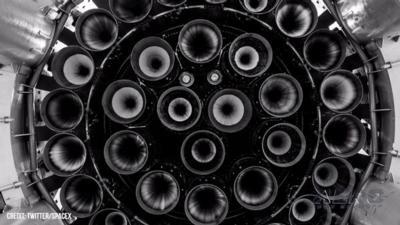Red Planet Caravan
During a video conference at the International Astronautical Congress in the Azerbaijani capital city of Baku, Elon Musk stated with confidence that SpaceX is well-positioned to make a successful landing on Mars within four-years.

Musk contended SpaceX's Starship—the largest, most powerful rocket yet conceived of by humankind, has “a decent chance” of reaching orbit on its second test flight. The spacecraft’s first orbital test flight , which took place in April 2023, fell somewhat short of resounding success.
The endeavor got off to a dramatic and promising start with the simultaneous firing of the 33 Raptor engines by which Starship’s Super Heavy first-stage booster is powered. As thousands looked on, the Boca Chica, Texas morning filled with the din and fiery fury of cryogenic liquid methane and oxygen combusting under 790 atmospheres (11,603-pounds-per-square-inch) of pressure.
For several impossibly long seconds, the great rocket, stacked stage-upon-stage to its imposing 230-foot height, remained motionless atop 17,100,000-lbf of thrust—the equivalent of 75 Boeing 777-300ERs at full take-off power.
Slowly, almost imperceptibly, the immense vessel commenced ascending, straining against Earth’s gravity to impel its 11-million-pound bulk spaceward.
A cheer went up from the launch-controllers assembled within SpaceX’s Starbase facility as Starship cleared the launch-pad tower, rising with increasing speed and certainty, persevering against incomprehensible forces with the preternatural stoicism peculiar to machines.
Gathering speed in earnest despite the failure of five of its first-stage Raptor engines, Starship rocketed past 16,000-feet, accelerating rapidly through 368-knots.
At approximately one-minute eight-seconds after lift-off, intermittent plumes of flame were observed within Starship’s otherwise stable thrust column. One-minute twenty-seconds into the flight, at an altitude of FL300 and a speed of 460-knots, Starship passed successfully through Max Q (maximum dynamic pressure), that point in a space-vehicle’s ascent at which its structure is subjected to maximum mechanical stress.

Two-minutes after liftoff, as Starship neared first-stage separation, a pronounced jet of flame erupted from the spacecraft’s thrust column. Fifty-seconds later, Starship’s directional thrusters fired, initiating an end-over-end flip—a planned maneuver by which the vehicle’s first-stage separation is preceded.
Three-minutes four-seconds after lift-off, the Starbase control room fell silent as Starship continued flipping, through 360°, 720°, 1,080°, directional thrusters firing intermittently in a losing battle against inertia and misfortune.
Three-minutes fifty-seconds into Starship’s first orbital launch attempt, commentators conceded “This does not appear to be a nominal situation.” Nine-seconds later, the great rocket—small and fragile-looking at an altitude of 95,144-feet and a velocity of 1,149-knots (1.7 Mach)—exploded in an adiabatic cataclysm of rapidly-depressurizing cryogenic fuels.
Characteristically reactionary, the FAA summarily grounded Starship before stipulating the implementation of 63 corrective actions—a bold gambit for an agency only semi-competent in the certification and oversight of conventional atmospheric aircraft.
Undeterred by the mishap and the paroxysm of regulatory claptrap precipitated thereby, SpaceX got down to the arduous business of crunching the immense volumes of data gleaned during Starship’s first orbital launch attempt and applying such to the machine’s betterment.

Musk’s optimistic comments vis-à-vis a near-future Starship mission to Mars mirror those set forth last year by SpaceX President and COO Gwynne Shotwell, who predicted human beings will walk the surface of Mars before 2030.
SpaceX’s Starship is a remarkable machine, a 390-foot-tall behemoth with a payload capacity of 330,000-pounds to Low Earth Orbit (LEO) in its fully reusable configuration, and 550,000-pounds to LEO if fully expended.
Starship is a composite vehicle consisting of an expendable, for now, Super Heavy booster, first stage and a reusable, Starship, second stage. The 230-foot-tall, 30-foot-wide Super Heavy booster section is powered by 33 of SpaceX’s proprietary Raptor engines arranged in concentric rings. At full-power, the stage’s complement of Raptor and Raptor Vacuum engines produces a staggering 17,100,000-pound-feet of thrust. The mighty Saturn V rocket by which NASA’s Apollo missions landed men on Earth’s moon produced a comparatively anemic 7.5-million.
The Starship second stage is 160-feet-tall, 30-feet in diameter, and fitted with three Raptor atmospheric and three additional Raptor Vacuum engines. The section’s 56-foot-tall by 26-foot diameter payload bay boasts an internal volume of 35,000-cubic-feet—slightly larger than the entirety of the International Space Station's pressurized volume. The Starship second stage functions as a self-contained spacecraft within which crew and cargo will journey into space.
Stacked and fueled, Starship’s first and second stages mass approximately 11,000,000-pounds.

Proposed applications of SpaceX’s Starship include supporting construction of the Starlink internet constellation, performing suborbital point-to-point flights, and conveying space-travelers and cargoes Earth orbit, the Moon, Mars, and the vastness beyond.
During his keynote speech before the attendees of 2023’s International Astronautical Congress, Must conceded he didn’t seek to “set expectations too high” for Starship’s sophomore orbital launch attempt. The SpaceX, Tesla, and “X” boss emphasized lessons learned from the flawed April Starship launch constituted a success of sorts.
Prior to undertaking a second Starship orbital launch attempt, SpaceX must obtain authorizations from the FAA and environmental approval form the U.S. Fish and Wildlife Service. It can be persuasively argued that red-tape, not gravity, is the unrelenting force against which the mighty rocket must strain to free itself not of Earth’s, but of Washington D.C.’s surly bonds.
 Bolen Gives Congress a Rare Thumbs-Up
Bolen Gives Congress a Rare Thumbs-Up The SportPlane Resource Guide RETURNS!!!!
The SportPlane Resource Guide RETURNS!!!! Buying Sprees Continue: Textron eAviation Takes On Amazilia Aerospace
Buying Sprees Continue: Textron eAviation Takes On Amazilia Aerospace Hawker 4000 Bizjets Gain Nav System, Data Link STC
Hawker 4000 Bizjets Gain Nav System, Data Link STC Echodyne Gets BVLOS Waiver for AiRanger Aircraft
Echodyne Gets BVLOS Waiver for AiRanger Aircraft






